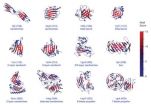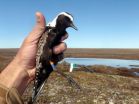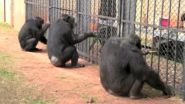(Press-News.org) CAMBRIDGE, MA -- When people get together in groups, unusual things can happen — both good and bad. Groups create important social institutions that an individual could not achieve alone, but there can be a darker side to such alliances: Belonging to a group makes people more likely to harm others outside the group.
"Although humans exhibit strong preferences for equity and moral prohibitions against harm in many contexts, people's priorities change when there is an 'us' and a 'them,'" says Rebecca Saxe, an associate professor of cognitive neuroscience at MIT. "A group of people will often engage in actions that are contrary to the private moral standards of each individual in that group, sweeping otherwise decent individuals into 'mobs' that commit looting, vandalism, even physical brutality."
Several factors play into this transformation. When people are in a group, they feel more anonymous, and less likely to be caught doing something wrong. They may also feel a diminished sense of personal responsibility for collective actions.
Saxe and colleagues recently studied a third factor that cognitive scientists believe may be involved in this group dynamic: the hypothesis that when people are in groups, they "lose touch" with their own morals and beliefs, and become more likely to do things that they would normally believe are wrong.
In a study that recently went online in the journal NeuroImage, the researchers measured brain activity in a part of the brain involved in thinking about oneself. They found that in some people, this activity was reduced when the subjects participated in a competition as part of a group, compared with when they competed as individuals. Those people were more likely to harm their competitors than people who did not exhibit this decreased brain activity.
"This process alone does not account for intergroup conflict: Groups also promote anonymity, diminish personal responsibility, and encourage reframing harmful actions as 'necessary for the greater good.' Still, these results suggest that at least in some cases, explicitly reflecting on one's own personal moral standards may help to attenuate the influence of 'mob mentality,'" says Mina Cikara, a former MIT postdoc and lead author of the NeuroImage paper.
Group dynamics
Cikara, who is now an assistant professor at Carnegie Mellon University, started this research project after experiencing the consequences of a "mob mentality": During a visit to Yankee Stadium, her husband was ceaselessly heckled by Yankees fans for wearing a Red Sox cap. "What I decided to do was take the hat from him, thinking I would be a lesser target by virtue of the fact that I was a woman," Cikara says. "I was so wrong. I have never been called names like that in my entire life."
The harassment, which continued throughout the trip back to Manhattan, provoked a strong reaction in Cikara, who isn't even a Red Sox fan.
"It was a really amazing experience because what I realized was I had gone from being an individual to being seen as a member of 'Red Sox Nation.' And the way that people responded to me, and the way I felt myself responding back, had changed, by virtue of this visual cue — the baseball hat," she says. "Once you start feeling attacked on behalf of your group, however arbitrary, it changes your psychology."
Cikara, then a third-year graduate student at Princeton University, started to investigate the neural mechanisms behind the group dynamics that produce bad behavior. In the new study, Cikara, Saxe (who is also an associate member of MIT's McGovern Institute for Brain Research), former Harvard University graduate student Anna Jenkins, and former MIT lab manager Nicholas Dufour focused on a part of the brain called the medial prefrontal cortex. When someone is reflecting on himself or herself, this part of the brain lights up in functional magnetic resonance imaging (fMRI) brain scans.
A couple of weeks before the study participants came in for the experiment, the researchers surveyed each of them about their social-media habits, as well as their moral beliefs and behavior. This allowed the researchers to create individualized statements for each subject that were true for that person — for example, "I have stolen food from shared refrigerators" or "I always apologize after bumping into someone."
When the subjects arrived at the lab, their brains were scanned as they played a game once on their own and once as part of a team. The purpose of the game was to press a button if they saw a statement related to social media, such as "I have more than 600 Facebook friends."
The subjects also saw their personalized moral statements mixed in with sentences about social media. Brain scans revealed that when subjects were playing for themselves, the medial prefrontal cortex lit up much more when they read the moral statements than the social media statements, consistent with previous findings. However, during the team competition, some people showed much lower medial prefrontal cortex activation when they saw the moral statements.
Those people also turned out to be much more likely to harm members of the competing group during a task performed after the game. Each subject was asked to select photos that would appear with the published study, from a set of four photos apiece of two teammates and two members of the opposing team. The subjects with suppressed medial prefrontal cortex activity chose the least flattering photos of the opposing team members, but not of their own teammates.
Getting lost
The researchers also found that after the game, people with reduced medial prefrontal cortex activity had more difficulty remembering the moral statements they had heard during the game.
"If you need to encode something with regard to the self and that ability is somehow undermined when you're competing with a group, then you should have poor memory associated with that reduction in medial prefrontal cortex signal, and that's exactly what we see," Cikara says.
Cikara hopes to follow up on these findings to investigate what makes some people more likely to become "lost" in a group than others. She is also interested in studying whether people are slower to recognize themselves or pick themselves out of a photo lineup after being absorbed in a group activity.
INFORMATION:
The research was funded by the Eunice Kennedy Shriver National Institute of Child Health and Human Development, the Air Force Office of Scientific Research, and the Packard Foundation.
When good people do bad things
2014-06-12
ELSE PRESS RELEASES FROM THIS DATE:
Study of white sharks in the northwest Atlantic offers optimistic outlook for recovery
2014-06-12
White sharks are among the largest, most widespread apex predators in the ocean, but are also among the most vulnerable. A new study, the most comprehensive ever on seasonal distribution patterns and historic trends in abundance of white sharks (Carcharodon carcharias) in the western North Atlantic Ocean, used records compiled over more than 200 years to update knowledge and fill in gaps in information about this species.
Scientists from NOAA Fisheries and colleagues added recent unpublished records to previously published data to present a broad picture of 649 confirmed ...
Antibodies from the desert as guides to diseased cells
2014-06-12
The use of nanoparticles in cancer research is considered as a promising approach in detecting and fighting tumour cells. The method has, however, often failed because the human immune system recognizes the particles as foreign objects and rejects them before they can fulfil their function. Researchers at the Helmholtz-Zentrum Dresden-Rossendorf (HZDR) and at University College Dublin in Ireland have, along with other partners, developed nanoparticles that not only bypass the body's defence system, but also find their way to the diseased cells. This procedure uses fragments ...
Proliferation cues 'natural killer' cells for job change
2014-06-12
PROVIDENCE, R.I. [Brown University] —The immune system maintains a rich abundance of "natural killer" cells to confront microbial invaders, but as the body gains the upper hand in various infections it sometimes starts to produce even more of the cells. For three decades, scientists haven't understood what purpose that serves. In a new paper, Brown University researchers show one: proliferation helps change the NK cells' function from stimulating the immune response to calming it down, lest it get out of hand.
In a series of experiments now published online in the Journal ...
The transmission of information via proteins could revolutionize drug discovery
2014-06-12
Proteins are chains of amino acids that, when folded into certain structural patterns and also when unfolded, exert functions within cells. Proteins receive signals that are transmitted from one to the next and that are essential for life. However, within a given protein, are there "highways" along which the signals travel, like a in a relay event? That is to say, how is the information transmitted in a given protein? "This is one of the key questions in biophysics," says Xavier Salvatella, ICREA Professor at the Institute for Research in Biomedicine (IRB Barcelona) and ...
Tiny plants ride on the coattails of migratory birds
2014-06-12
Since the days of Darwin, biologists have questioned why certain plants occur in widely separated places, the farthest reaches of North American and the Southern tip of South America but nowhere in between. How did they get there? An international team of researchers have now found an important piece of the puzzle: migratory birds about to fly to South America from the Arctic harbor small plant parts in their feathers.
In the past several decades, scientists have discovered that the North – South distributions of certain plants often result from a single jump across the ...
Chimpanzees spontaneously initiate and maintain cooperative behavior
2014-06-12
VIDEO:
Chimpanzees spontaneously cooperate with multiple partners of their choosing to remove a barrier and pull in a tray baited with food.
Click here for more information.
Without any pre-training or restrictions in partner choice among chimpanzees, researchers at the Yerkes National Primate Research Center, Emory University, found for the first time that chimpanzees housed in a socially complex, contained setting spontaneously cooperate with multiple partners of their choosing. ...
All men with gout should be routinely screened for erectile dysfunction
2014-06-12
A new study presented today at the European League Against Rheumatism Annual Congress (EULAR 2014) showed that erectile dysfunction (ED) is present in most men with gout and is frequently severe.1
In a survey of 201 men, 83 had gout, of whom a significantly greater proportion had ED (76%) compared with those patients without gout (52%) (p= 0.0007). Also, a significantly greater proportion of gout patients (43%) had severe ED compared with patients without gout (30%) (p=0.007).1
According to lead author Dr. Naomi Schlesinger, Chief, Division of Rheumatology and Professor ...
Potential anti-TNF response biomarker identified
2014-06-12
DNA methylation has been identified as a potential biomarker of response to etanercept and adalimumab in patients with rheumatoid arthritis (RA) according to preliminary results from one of the largest methylome-wide investigations of treatment response to anti-TNF therapies.1 These data, presented today at the European League Against Rheumatism Annual Congress (EULAR 2014), bring clinicians a step closer to being able to personalise a patient's treatment pathway.
Anti-TNF therapies have proved a huge advance for the treatment of rheumatoid arthritis and have transformed ...
Regular exercise beneficial in suppressing inflammation in rheumatic disease
2014-06-12
Research findings presented today at the European League Against Rheumatism Annual Congress (EULAR 2014) suggest that exercise transiently suppresses local and systemic inflammation, reinforcing the beneficial effects of exercise and the need for this to be regular in order to achieve clinical efficacy in rheumatic disease.
Chronic inflammation, swelling and pain in the joints characterise the more than 200 rheumatic diseases. Persistent inflammation over time can damage affected joints, but previous research has established that exercise can decrease joint inflammation ...
Cranial ultrasound may replace temporal artery biopsy in diagnosis of giant cell arteritis
2014-06-12
A new study presented for the first time today at the European League Against Rheumatism Annual Congress (EULAR 2014), shows that cranial ultrasound has a greater sensitivity than temporal artery biopsy,* and a comparable specificity in the diagnosis of Giant Cell Arteritis (GCA).1
Giant Cell Arteritis (GCA), a condition in which medium and large arteries mainly in the head and neck, become inflamed and narrowed, can cause blindness due to occlusion of the artery supplying the back of the eye. It is therefore essential that a prompt, accurate diagnosis of GCA is made ...



